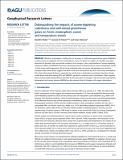Distinguishing the impacts of ozone-depleting substances and well-mixed greenhouse gases on Arctic stratospheric ozone and temperature trends
Author(s)
Rieder, Harald E.; Polvani, Lorenzo M.; Solomon, Susan
DownloadSolomon_Distinguishing the.pdf (1.369Mb)
PUBLISHER_POLICY
Publisher Policy
Article is made available in accordance with the publisher's policy and may be subject to US copyright law. Please refer to the publisher's site for terms of use.
Terms of use
Metadata
Show full item recordAbstract
Whether stratospheric cooling due to increases in well-mixed greenhouse gases (WMGHG) could increase the depletion of Arctic stratospheric ozone has been the subject of scientific and public attention for decades. Here we provide evidence that changes in the concentrations of ozone-depleting substances (ODS), not WMGHG, have been the primary driver of observed Arctic lower stratospheric trends in both ozone and temperature. We do so by analyzing polar cap ozone and temperature trends in reanalysis data: these clearly suggest that both trends are mainly driven by ODS in the lower stratosphere. This observation-based finding is supported by results from a stratosphere-resolving chemistry-climate model driven with time-varying ODS and WMGHG, specified in isolation and in combination. Taken together, these results provide strong evidence that ODS are the main driver of changes in the Arctic lower stratospheric temperatures and ozone, whereas WMGHG are the primary driver of changes in the upper stratosphere.
Date issued
2014-04Department
Massachusetts Institute of Technology. Department of Earth, Atmospheric, and Planetary SciencesJournal
Geophysical Research Letters
Publisher
American Geophysical Union (AGU)
Citation
Rieder, Harald E., Lorenzo M. Polvani, and Susan Solomon. “Distinguishing the Impacts of Ozone-Depleting Substances and Well-Mixed Greenhouse Gases on Arctic Stratospheric Ozone and Temperature Trends.” Geophysical Research Letters 41, no. 7 (April 11, 2014): 2652–2660. © 2014 American Geophysical Union
Version: Final published version
ISSN
00948276